Dr. Antonios Garas
I am a senior researcher at the Chair of Systems Design, and experienced IT administrator (head of the IT team).
My current research is about structural properties, stability, and efficiency of complex interconnected and temporal networks.
More precisely, I study how dynamical processes evolving on a complex system are related to fundamental properties of its underlying network topology. Using data-driven modelling, I am exploring applications of these subjects to various fields ranging from Physics to Sociology and Economy.
CV» |
|
|
Publications»
«Publications
Publications in


Higher-order models capture changes in controllability of temporal networks
|
[2021]
|
|
Zhang, Yan;
Garas, Antonios;
Scholtes, Ingo
|
Journal of Physics: Complexity,
pages: 015007,
volume: 2
|
more» «less
|
Abstract
In many complex systems, elements interact via time-varying network topologies.Recent research shows that temporal correlations in the chronological ordering of interactions crucially influence network properties and dynamical processes.How these correlations affect our ability to control systems with time-varying interactions remains unclear. In this work, we use higher-order network models to extend the framework of structural controllability to temporal networks, where the chronological ordering of interactions gives rise to time-respecting paths with non-Markovian characteristics.We study six empirical data sets and show that non-Markovian characteristics of real systems can both increase or decrease the minimum time needed to control the whole system.With both empirical data and synthetic models, we further show that spectral properties of generalisations of graph Laplacians to higher-order networks can be used to analytically capture the effect of temporal correlations on controllability. Our work highlights that (i) correlations in the chronological ordering of interactions are an important source of complexity that significantly influences the controllability of temporal networks, and (ii) higher-order network models are a powerful tool to understand the temporal-topological characteristics of empirical systems.

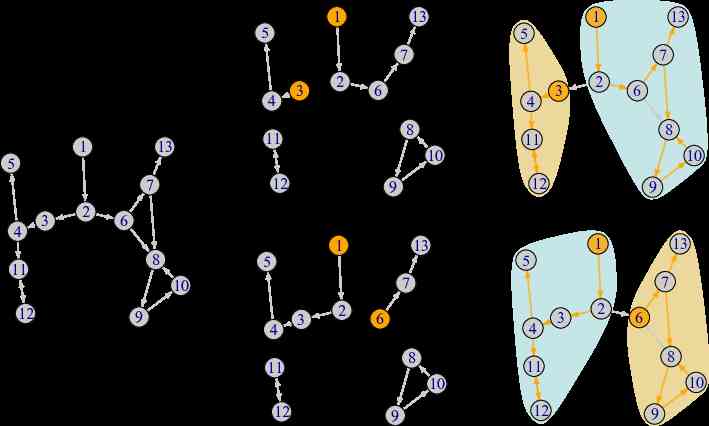
Control contribution identifies top driver nodes in complex networks
|
[2019]
|
|
Zhang, Yan;
Garas, Antonios;
Schweitzer, Frank
|
ACS-Advances in Complex Systems,
pages: 1950014,
volume: 22,
number: 7-8
|
more» «less
|
Abstract
We propose a new measure to quantify the impact of a node $i$ in controlling a directed network. This measure, called ``control contribution'' $_(i)$, combines the probability for node $i$ to appear in a set of driver nodes and the probability for other nodes to be controlled by $i$. To calculate $_(i)$, we propose an optimization method based on random samples of minimum sets of drivers. Using real-world and synthetic networks, we find very broad distributions of $C_(i)$. Ranking nodes according to their $C_(i)$ values allows us to identify the top driver nodes that can control most of the network. We show that this ranking is superior to rankings based on other control-based measures. We find that control contribution indeed contains new information that cannot be traced back to degree, control capacity or control range of a node.

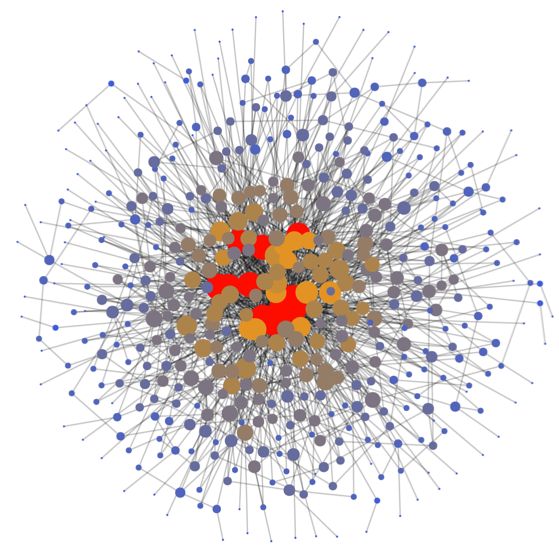
Probing the robustness of nested multi-layer networks
|
[2019]
|
|
Casiraghi, Giona;
Garas, Antonios;
Schweitzer, Frank
|
arXiv:1911.03277
|
more» «less
|
Abstract
We consider a multi-layer network with two layers, $\_1\$, $\_2\$. Their intra-layer topology shows a scale-free degree distribution and a core-periphery structure. A nested structure describes the inter-layer topology, i.e., some nodes from $\_1\$, the generalists, have many links to nodes in $\_2\$, specialists only have a few. This structure is verified by analyzing two empirical networks from ecology and economics. To probe the robustness of the multi-layer network, we remove nodes from $\_1\$ with their inter-and intra-layer links and measure the impact on the size of the largest connected component, $F_2\$, in $\_2\$, which we take as a robustness measure. We test different attack scenarios by preferably removing peripheral or core nodes. We also vary the intra-layer coupling between generalists and specialists, to study their impact on the robustness of the multi-layer network. We find that some combinations of attack scenario and intra-layer coupling lead to very low robustness values, whereas others demonstrate high robustness of the multi-layer network because of the intra-layer links. Our results shed new light on the robustness of bipartite networks, which consider only inter-layer, but no intra-layer links.

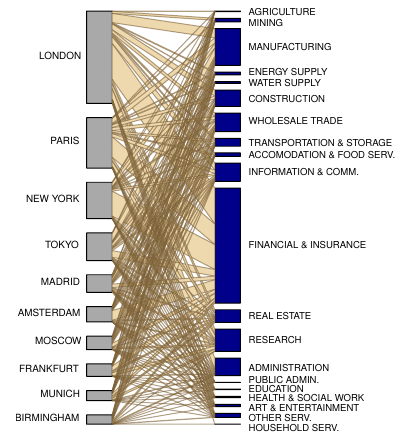
Economic Specialization and the Nested Bipartite Network of City-Firm Relations
|
[2019]
|
|
Garas, Antonios;
Rozenblat, C'eline;
Schweitzer, Frank
|
Multiplex and Multilevel Networks
|
more» «less
|
Abstract
How are economic activities linked to geographic locations? To answer this question, we use a data-driven approach that builds on the information about location, ownership and economic activities of the world's 3,000 largest firms and their almost one million subsidiaries. From this information we generate a bipartite network of cities linked to economic activities. Analysing the structure of this network, we find striking similarities with nested networks observed in ecology, where links represent mutualistic interactions between species. This motivates us to apply ecological indicators to identify the unbalanced deployment of economic activities. Such deployment can lead to an over-representation of specific economic sectors in a given city, and poses a significant thread for the city's future especially in times when the over-represented activities face economic uncertainties. If we compare our analysis with external rankings about the quality of life in a city, we find that the nested structure of the city-firm network also reflects such information about the quality of life, which can usually be assessed only via dedicated survey-based indicators.


Multiplex and Multilevel Networks
|
[2018]
|
|
Caldarelli, Guido;
Garas, Antonios;
Battiston, Stefano
|
Multiplex and Multilevel Networks
|
more» «less
|
Abstract
Multiplex and Multilayer Networks is a collection of some of the results obtained in the new field of complex networks theory with respect to multilevel, multiplex, and interacting networks. The ever-increasing availability of data in fields ranging from computer science to urban systems, medicine, economics, and finance shows that networks that were usually perceived as distinct and isolated are, in reality, interacting with other networks. While this sounds like a trivial observation, the interactions in multilevel complex networks can lead to unexpected behaviors and allow systemic vulnerabilities to emerge. The research activities of many different laboratories and groups in this field have been financed by the EU MULTIPLEX project (http://www.multiplexproject.eu). This project utilized 23 distinct research teams across Europe and, from 2012 to 2016, explored this new area of research. The results, presented in this volume, range from the theory of static multinetworks to dynamical process on them, to their percolating properties, and, finally, to applications in the case of social systems.

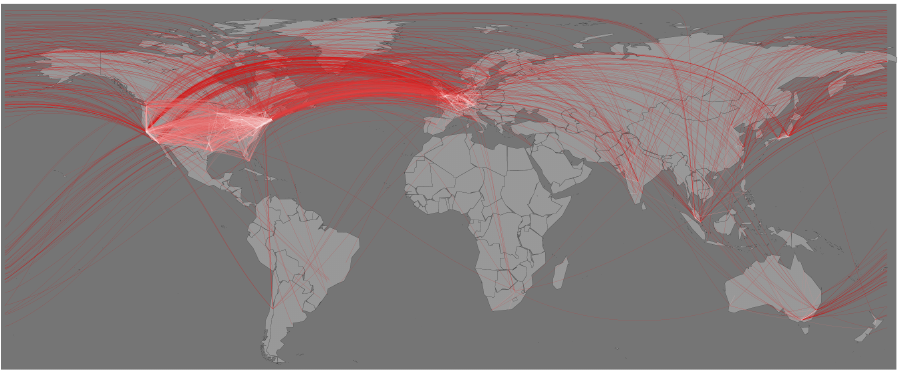
The spatial component of R&D networks
|
[2018]
|
|
Scholl, Tobias;
Garas, Antonios;
Schweitzer, Frank
|
Journal of Evolutionary Economics,
pages: 417-436,
volume: 28,
number: 2
|
more» «less
|
Abstract
We study the role of geography in R&D networks by means of a quantitative, micro-geographic approach. Using a large database that covers international R&D collaborations from 1984 to 2009, we localize each actor precisely in space through its latitude and longitude. This allows us to analyze the R&D network at all geographic scales simultaneously. Our empirical results show that despite the high importance of the city level, transnational R&D collaborations at large distances are much more frequent than expected from similar networks. This provides evidence for the ambiguity of distance in economic cooperation which is also suggested by the existing literature. In addition we test whether the hypothesis of local buzz and global pipelines applies to the observed R&D network by calculating well-defined metrics from network theory.

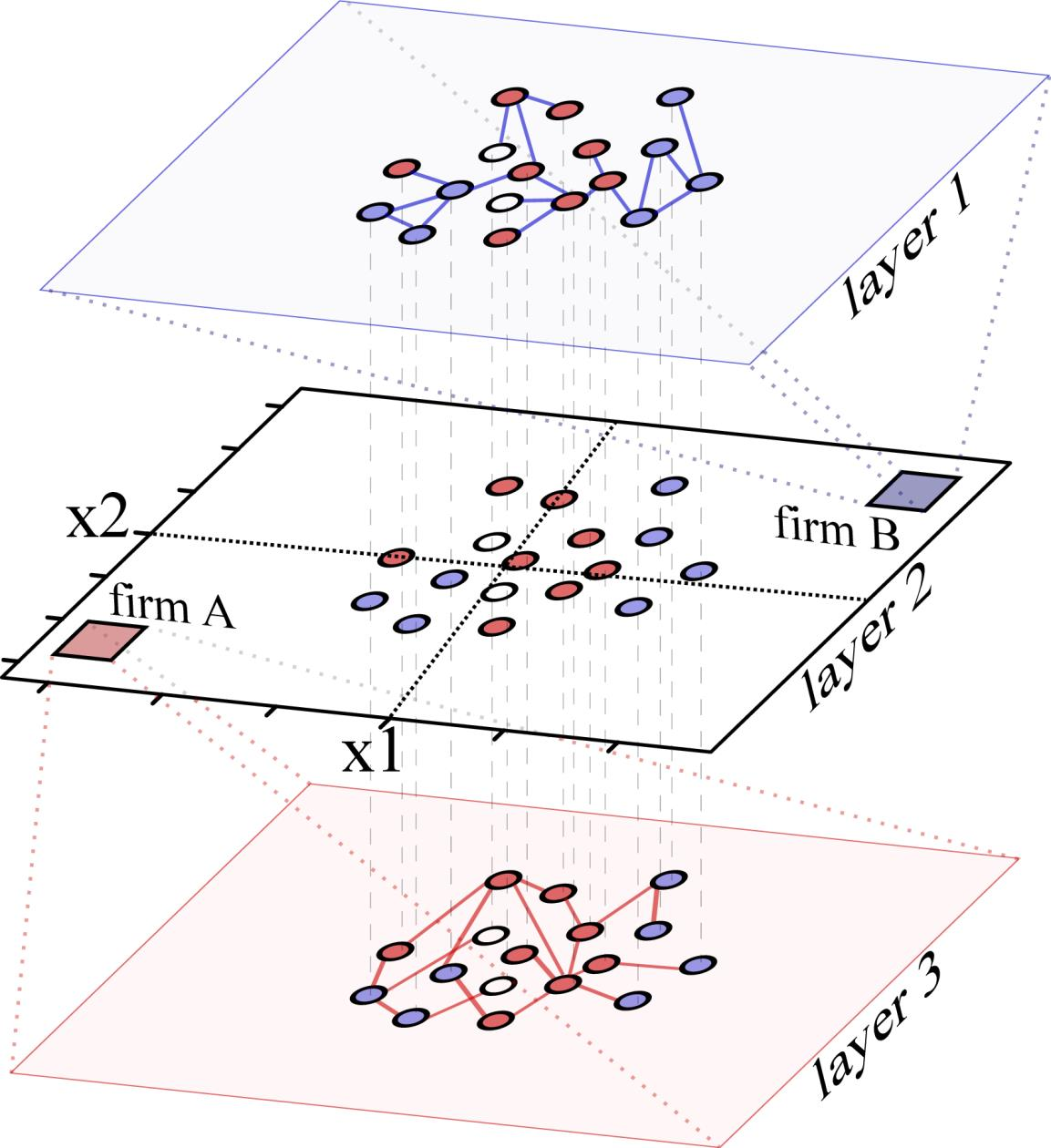
The role of consumer networks in firms’ multi-characteristics competition and market-share inequality
|
[2017]
|
|
Garas, Antonios;
Lapatinas, Athanasios
|
Structural Change and Economic Dynamics,
pages: 76-86,
volume: 43
|
more» «less
|
Abstract
We develop a location analysis spatial model of firms' competition in multi-characteristics space, where consumers' opinions about the firms' products are distributed on multilayered networks. Firms do not compete on price but only on location upon the products' multi-characteristics space, and they aim to attract the maximum number of consumers. Boundedly rational consumers have distinct ideal points/tastes over the possible available firm locations but, crucially, they are affected by the opinions of their neighbors. Proposing a dynamic agent-based analysis on firms' location choice we characterize multi-dimensional product differentiation competition as adaptive learning by firms' managers and we argue that such a complex systems approach advances the analysis in alternative ways, beyond game-theoretic calculations.


Controllability of temporal networks: An analysis using higher-order networks
|
[2017]
|
|
Zhang, Yan;
Garas, Antonios;
Scholtes, Ingo
|
arXiv:1701.06331
|
more» «less
|
Abstract
In this manuscript, we show how higher-order graphical models can be applied to study the controllability of networked systems with dynamic topologies. Studying empirical data on temporal networks, we specifically show that the order correlations in the activation sequence of links can both increase or reduce the time needed to achieve full controllability. We then demonstrate how spectral properties of higher-order graphical models can be used to analytically explain the effect of order correlations on controllability in temporal networks.

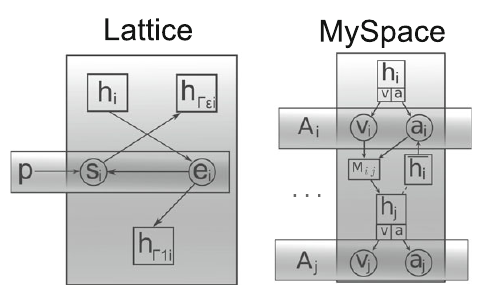
An Agent-Based Modeling Framework for Online Collective Emotions
|
[2017]
|
|
Garcia, David;
Garas, Antonios;
Schweitzer, Frank
|
Cyberemotions: Collective Emotions in Cyberspace
|
more» «less
|
Abstract
Online communication takes a variety of shapes in the different technological media that allow users interact with each other, with their friends, or with arbitrarily large groups. These serve as breeding grounds for collective emotions, in which large amounts of users share emotional states through time. We present our modeling framework for collective emotions in online communities, which can be adapted for the different kinds of online interaction present in the cyberspace. This framework allows the design of agent-based models, in which agents’ emotional states are represented according to psychological theories. This approach aims at a unification of modeling efforts, connecting the sentiment analysis of big data with psychological experiments, through tractable agent-based models. We illustrate the applications of this framework to different online communities, including product reviews, chatrooms, virtual realities, and social networking sites. We show how our model reproduces properties of collective emotions in the reviews of Amazon, and the group discussions of IRC channels. We comment the applications of this framework for data-driven simulation of emotions, and how we formulate testable hypotheses of emotion dynamics for future research on the field.


The Rise and Fall of R&D Networks
|
[2017]
|
|
Tomasello, Mario Vincenzo;
Napoletano, Mauro;
Garas, Antonios;
Schweitzer, Frank
|
ICC - Industrial and Corporate Change,
pages: 617-646,
volume: 26,
number: 4
|
more» «less
|
Abstract
Drawing on a large database of publicly announced R&D alliances, we empirically investigate the evolution of R&D networks and the process of alliance formation in several manufacturing sectors over a 24-year period (1986-2009). Our goal is to empirically evaluate the temporal and sectoral robustness of a large set of network indicators, thus providing a more complete description of R&D networks with respect to the existing literature. We find that most network properties are not only invariant across sectors, but also independent of the scale of aggregation at which they are observed, and we highlight the presence of core-periphery architectures in explaining some properties emphasized in previous empirical studies (e.g. asymmetric degree distributions and small worlds). In addition, we show that many properties of R&D networks are characterized by a rise-and-fall dynamics with a peak in the mid-nineties. We find that such dynamics is driven by mechanisms of accumulative advantage, structural homophily and multiconnectivity. In particular, the change from the "rise" to the "fall" phase is associated to a structural break in the importance of multiconnectivity.


Newcomers vs. incumbents: How firms select their partners for R&D collaborations
|
[2017]
|
|
Garas, Antonios;
Tomasello, Mario Vincenzo;
Schweitzer, Frank
|
arXiv:1403.3298
|
more» «less
|
Abstract
This paper studies the selection of partners for R&D collaborations of firms both empirically, by analyzing a large data set of R&D alliances over 25 years, and theoretically, by utilizing an agent-based model of alliance formation. We quantify the topological position of a firm in the R&D network by means of the weighted k-core decomposition which assigns a coreness value to each firm. The evolution of these coreness values over time reconstructs the career path of individual firms, where lower coreness indicates a better integration of firms in an evolving R&D network. Using a large patent dataset, we demonstrate that coreness values strongly correlate with the number of patents of a firm. Analyzing coreness differences between firms and their partners, we identify a change in selecting partners: less integrated firms choose partners of similar coreness until they reach their best network position. After that, well integrated firms (with low coreness) choose preferably partners with high coreness, either newcomers or firms from the periphery. We use the agent-based model to test whether this change in behavior needs to be explained by means of strategic considerations, i.e. firms switching their strategy in choosing partners dependent on their network position. We find that the observed behavior can be well reproduced without such strategic considerations, this way challenging the role of strategies in explaining macro patterns of collaborations.
Interconnected Networks
|
[2016]
|
|
Garas, Antonios
|
|
|
more» «less
|
Abstract
This volume provides an introduction to and overview of the emerging field of interconnected networks which include multilayer or multiplex networks, as well as networks of networks. Such networks present structural and dynamical features quite different from those observed in isolated networks. The presence of links between different networks or layers of a network typically alters the way such interconnected networks behave – understanding the role of interconnecting links is therefore a crucial step towards a more accurate description of real-world systems. While examples of such dissimilar properties are becoming more abundant – for example regarding diffusion, robustness and competition – the root of such differences remains to be elucidated.
Each chapter in this topical collection is self-contained and can be read on its own, thus making it also suitable as reference for experienced researchers wishing to focus on a particular topic.

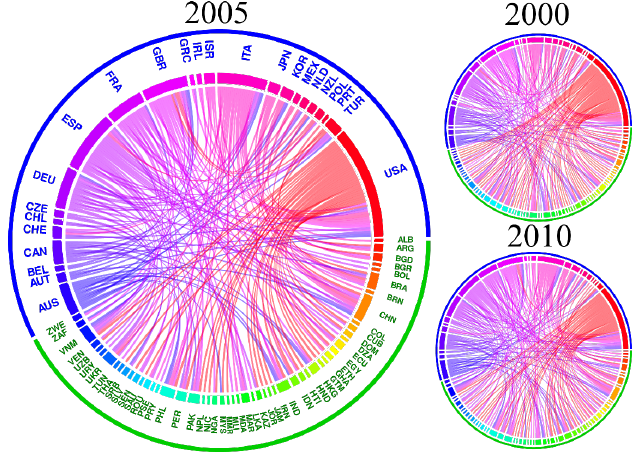
The relation between migration and FDI in the OECD from a complex network perspective
|
[2016]
|
|
Garas, Antonios;
Lapatinas, Athanasios;
Poulios, Konstantinos
|
Advances in Complex Systems,
pages: 1650009
|
more» «less
|
Abstract
We explore the relationship between human migration and OECD’s Foreign Direct Investment
(FDI) using a gravity equation enriched with variables that account for complex-network effects.
Based on a panel data analysis, we find a strong positive correlation between the migration network
and the FDI network, which can be mostly explained by countries’ economic/demographic sizes
and geographical distance. We highlight the existence of a stronger positive FDI relationship in
pairs of countries that are more central in the migration network. Both intensive and extensive
forms of centrality are FDI enhancing. Illuminating this result, we show that bilateral FDI between
any two countries is further affected positively by the complex web of 'third party'
corridors/migration stocks of the international migration network. Our findings are consistent
whether we consider bilateral FDI and bilateral migration figures, or we focus on the outward FDI
and the respective inward migration of the OECD countries.

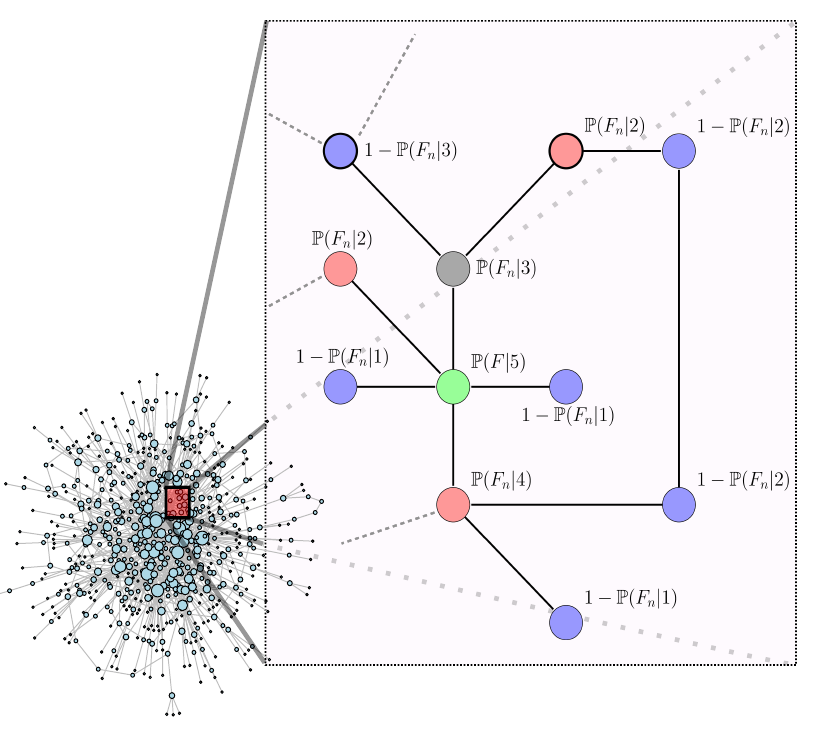
How damage diversification can reduce systemic risk
|
[2016]
|
|
Burkholz, Rebekka;
Garas, Antonios;
Schweitzer, Frank
|
Physical Review E,
pages: 042313,
volume: 93
|
more» «less
|
Abstract
We study the influence of risk diversification on cascading failures in weighted complex networks, where weighted directed links represent exposures between nodes. These weights result from different diversification strategies and their adjustment allows us to reduce systemic risk significantly by topological means. As an example, we contrast a classical exposure diversification (ED) approach with a damage diversification (DD) variant. The latter reduces the loss that the failure of high degree nodes generally inflict to their network neighbors and thus hampers the cascade amplification. To quantify the final cascade size and obtain our results, we develop a branching process approximation taking into account that inflicted losses cannot only depend on properties of the exposed, but also of the failing node. This analytic extension is a natural consequence of the paradigm shift from individual to system safety. To deepen our understanding of the cascade process, we complement this systemic perspective by a mesoscopic one: an analysis of the failure risk of nodes dependent on their degree. Additionally, we ask for the role of these failures in the cascade amplification.

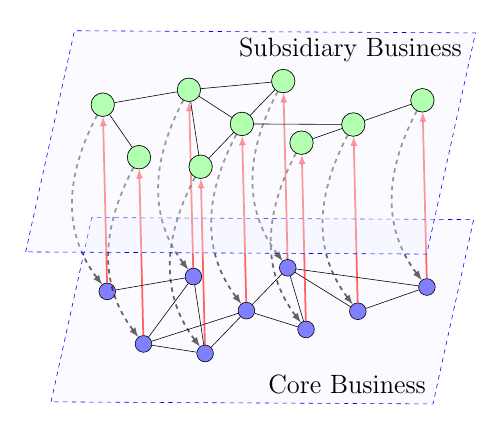
Systemic risk in multiplex networks with asymmetric coupling and threshold feedback
|
[2016]
|
|
Burkholz, Rebekka;
Leduc, Matt;
Garas, Antonios;
Schweitzer, Frank
|
Physica D,
pages: 64--72,
volume: 323-324
|
more» «less
|
Abstract
We study cascades on a two-layer multiplex network, with asymmetric feedback that depends on the coupling strength between the layers. Based on an analytical branching process approximation, we calculate the systemic risk measured by the final fraction of failed nodes on a reference layer. The results are compared with the case of a single layer network that is an aggregated representation of the two layers. We find that systemic risk in the two-layer network is smaller than in the aggregated one only if the coupling strength between the two layers is small. Above a critical coupling strength, systemic risk is increased because of the mutual amplification of cascades in the two layers. We even observe sharp phase transitions in the cascade size that are less pronounced on the aggregated layer. Our insights can be applied to a scenario where firms decide whether they want to split their business into a less risky core business and a more risky subsidiary business. In most cases, this may lead to a drastic increase of systemic risk, which is underestimated in an aggregated approach.

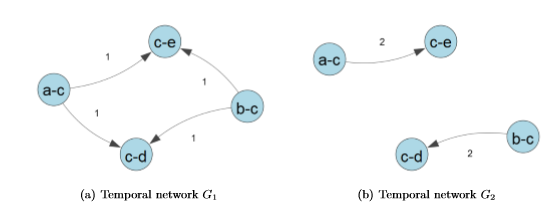
Higher-Order Aggregate Networks in the Analysis of Temporal Networks: Path structures and centralities
|
[2016]
|
|
Scholtes, Ingo;
Wider, Nicolas;
Garas, Antonios
|
European Physical Journal B,
pages: 1--15,
volume: 89,
number: 3
|
more» «less
|
Abstract
Recent research on temporal networks has highlighted the limitations of a static network perspective for our understanding of complex systems with dynamic topologies. In particular, recent works have shown that i) the specific order in which links occur in real-world temporal networks affects causality structures and thus the evolution of dynamical processes, and ii) higher-order aggregate representations of temporal networks can be used to analytically study the effect of these order correlations on dynamical processes. In this article we analyze the effect of order correlations on path-based centrality measures in real-world temporal networks. Analyzing temporal equivalents of betweenness, closeness and reach centrality in six empirical temporal networks, we first show that an analysis of the commonly used static, time-aggregated representation can give misleading results about the actual importance of nodes. We further study higher-order time-aggregated networks, a recently proposed generalization of the commonly applied static, time-aggregated representation of temporal networks. Here, we particularly define path-based centrality measures based on second-order aggregate networks, empirically validating that node centralities calculated in this way better capture the true temporal centralities of nodes than node centralities calculated based on the commonly used static (first-order) representation. Apart from providing a simple and practical method for the approximation of path-based centralities in temporal networks, our results highlight interesting perspectives for the use of higher-order aggregate networks in the analysis of time-stamped network data.

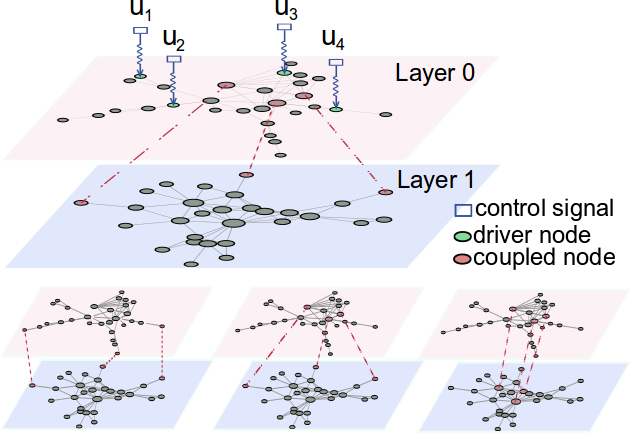
Value of peripheral nodes in controlling multilayer scale-free networks
|
[2016]
|
|
Zhang, Yan;
Garas, Antonios;
Schweitzer, Frank
|
Physical Review E,
pages: 012309,
volume: 93
|
more» «less
|
Abstract
We analyze the controllability of a two-layer network, where driver nodes can be chosen randomly only from one layer. Each layer contains a scale-free network with directed links and the node dynamics depends on the incoming links from other nodes. We combine the in-degree and out-degree values to assign an importance value w to each node, and distinguish between peripheral nodes with low w and central nodes with high w. Based on numerical simulations, we find that the controllable part of the network is larger when choosing low w nodes to connect the two layers. The control is as efficient when peripheral nodes are driver nodes as it is for the case of more central nodes. However, if we assume a cost to utilize nodes that is proportional to their overall degree, utilizing peripheral nodes to connect the two layers or to act as driver nodes is not only the most cost-efficient solution, it is also the one that performs best in controlling the two-layer network among the different interconnecting strategies we have tested.
An ensemble perspective on multi-layer networks
|
[2016]
|
|
Wider, Nicolas;
Garas, Antonios;
Scholtes, Ingo;
Schweitzer, Frank
|
Interconnected Networks
|
more» «less
|
Abstract
We study properties of multi-layered, interconnected networks from an ensemble perspective, i.e. we analyze ensembles of multi-layer networks that share similar aggregate characteristics. Using a diffusive process that evolves on a multi-layer network, we analyze how the speed of diffusion depends on the aggregate characteristics of both intra- and inter-layer connectivity. Through a block-matrix model representing the distinct layers, we construct transition matrices of random walkers on multi-layer networks, and estimate expected properties of multi-layer networks using a mean-field approach. In addition, we quantify and explore conditions on the link topology that allow to estimate the ensemble average by only considering aggregate statistics of the layers. Our approach can be used when only partial information is available, like it is usually the case for real-world multi-layer complex systems.

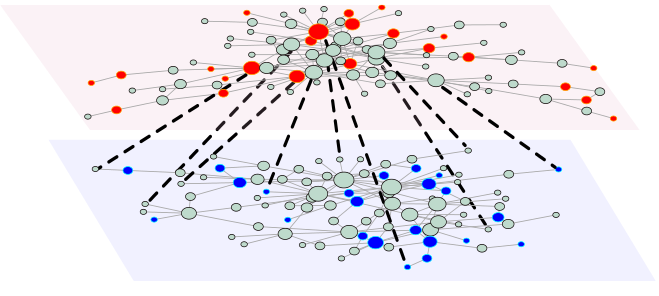
Reaction-Diffusion Processes on Interconnected Scale-Free Networks
|
[2015]
|
|
Garas, Antonios
|
Physical Review E,
pages: 020801(R),
volume: 92
|
more» «less
|
Abstract
We study the two-particle annihilation reaction A+B→∅ on interconnected scale-free networks, using different interconnecting strategies. We explore how the mixing of particles and the process evolution are influenced by the number of interconnecting links, by their functional properties, and by the interconnectivity strategies in use. We show that the reaction rates on this system are faster than what was observed in other topologies, due to the better particle mixing that suppresses the segregation effect, in line with previous studies performed on single scale-free networks.

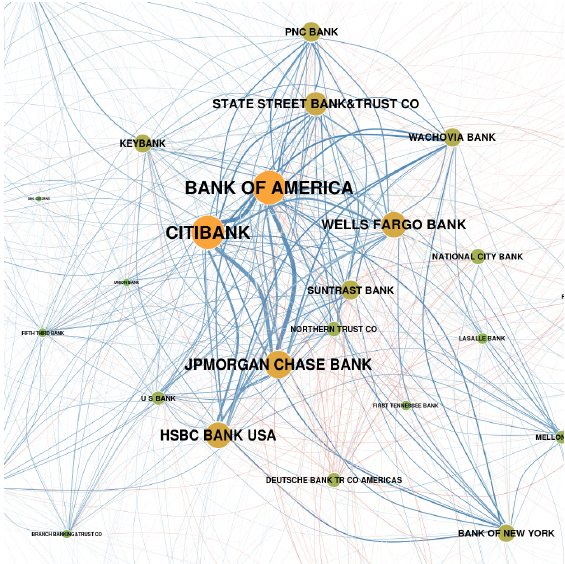
The Network of Counterparty Risk: Analysing Correlations in OTC Derivatives
|
[2015]
|
|
Nanumyan, Vahan;
Garas, Antonios;
Schweitzer, Frank
|
PLOS ONE,
pages: e0136638,
volume: 10
|
more» «less
|
Abstract
Counterparty risk denotes the risk that a party defaults in a bilateral contract. This risk not only depends on the two parties involved, but also on the risk from various other contracts each of these parties holds. In rather informal markets, such as the OTC (over-the-counter) derivative market, institutions only report their aggregated quarterly risk exposure, but no details about their counterparties. Hence, little is known about the diversification of counterparty risk. In this paper, we reconstruct the weighted and time-dependent network of counterparty risk in the OTC derivatives market of the United States between 1998 and 2012. To proxy unknown bilateral exposures, we first study the co-occurrence patterns of institutions based on their quarterly activity and ranking in the official report. The network obtained this way is further analysed by a weighted k-core decomposition, to reveal a core-periphery structure. This allows us to compare the activity-based ranking with a topology-based ranking, to identify the most important institutions and their mutual dependencies. We also analyse correlations in these activities, to show strong similarities in the behavior of the core institutions. Our analysis clearly demonstrates the clustering of counterparty risk in a small set of about a dozen US banks. This not only increases the default risk of the central institutions, but also the default risk of peripheral institutions which have contracts with the central ones. Hence, all institutions indirectly have to bear (part of) the counterparty risk of all others, which needs to be better reflected in the price of OTC derivatives.
Remarks
Find the Supporting Information at DOI:10.1371/journal.pone.0136638.s001

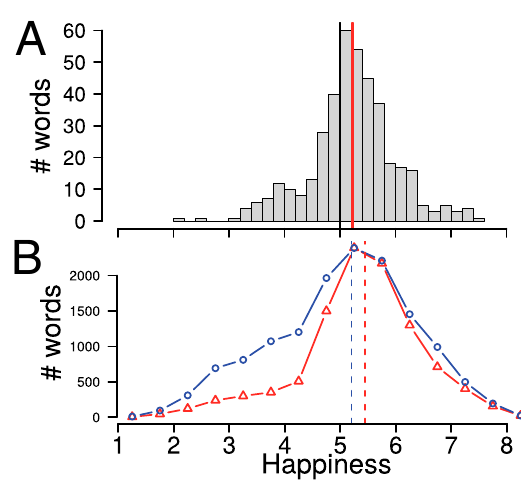
The language-dependent relationship between word happiness and frequency
|
[2015]
|
|
Garcia, David;
Garas, Antonios;
Schweitzer, Frank
|
Proceedings of the National Academy of Sciences,
pages: 201502909,
volume: 112,
number: 23
|
more» «less
|
Abstract
Dodds et al. (1) present a universal positivity bias—in 10 human languages—that they claim is independent of word frequency. This result contradicts previous findings (2, 3) in which a relationship between word happiness and frequency is reported for a variety of languages and large-scale datasets. To better understand this contradiction, we reanalyze the labMT (language assessment by Mechanical Turk) data produced in Dodds et al. (1) against a larger reference lexicon (3). Our reanalysis shows that the data used in Dodds et al. (1) does not support their claims.

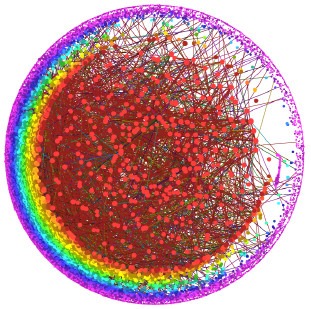
Emotions and Activity Profiles of Influential Users in Product Reviews Communities
|
[2015]
|
|
Tanase, Dorian;
Garcia, David;
Garas, Antonios;
Schweitzer, Frank
|
Frontiers in Physics,
volume: 3,
number: 87
|
more» «less
|
Abstract
Viral marketing seeks to maximize the spread of a campaign
through an online social network, often targeting influential nodes with high
centrality. In this article, we analyze behavioral aspects of influential
users in trust-based product reviews communities, quantifying emotional
expression, helpfulness, and user activity level. We focus on two independent
product review communities, Dooyoo and Epinions, in which
users can write product reviews and define trust links to filter product
recommendations. Following the patterns of social contagion processes, we
measure user social influence by means of the k-shell decomposition of trust
networks. For each of these users, we apply sentiment analysis to extract
their extent of positive, negative, and neutral emotional expression. In
addition, we quantify the level of feedback they received in their reviews,
the length of their contributions, and their level of activity over their
lifetime in the community. We find that users of both communities exhibit a
large heterogeneity of social influence, and that helpfulness votes and age
are significantly better predictors of the influence of an individual than
sentiment. The most active of the analyzed communities shows a particular
structure, in which the inner core of users is qualitatively different from
its periphery in terms of a stronger positive and negative emotional
expression. These results suggest that both objective and subjective aspects
of reviews are relevant to the communication of subjective experience.

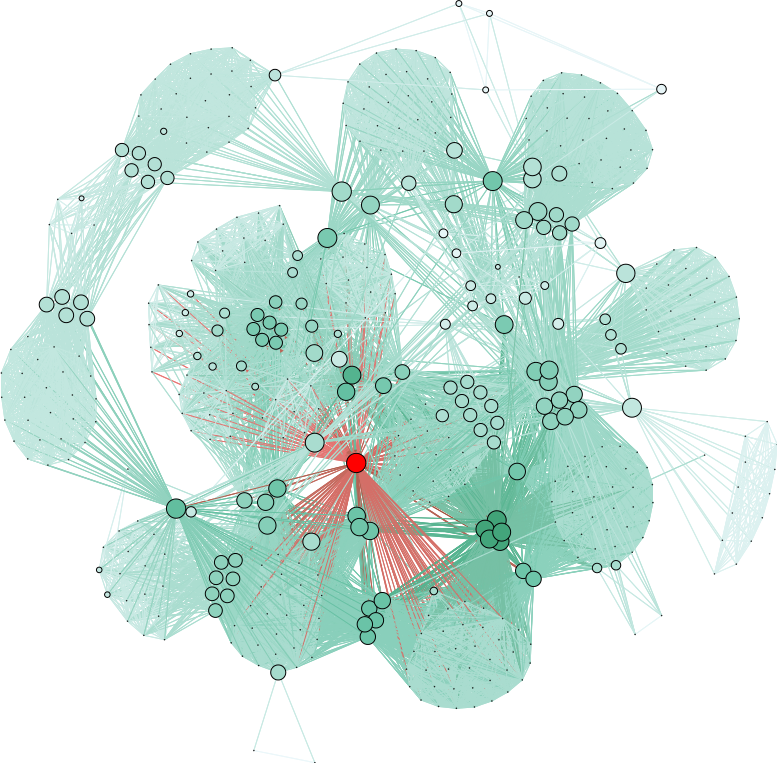
Predicting Scientific Success Based on Coauthorship Networks
|
[2014]
|
|
Sarigol, Emre;
Pfitzner, Rene;
Scholtes, Ingo;
Garas, Antonios;
Schweitzer, Frank
|
EPJ Data Science,
pages: 9,
volume: 3
|
more» «less
|
Abstract
We address the question to what extent the success of scientific articles is due to social influence. Analyzing a data set of over 100000 publications from the field of Computer Science, we study how centrality in the coauthorship network differs between authors who have highly cited papers and those who do not. We further show that a machine learning classifier, based only on coauthorship network centrality measures at time of publication, is able to predict with high precision whether an article will be highly cited five years after publication. By this we provide quantitative insight into the social dimension of scientific publishing - challenging the perception of citations as an objective, socially unbiased measure of scientific success.

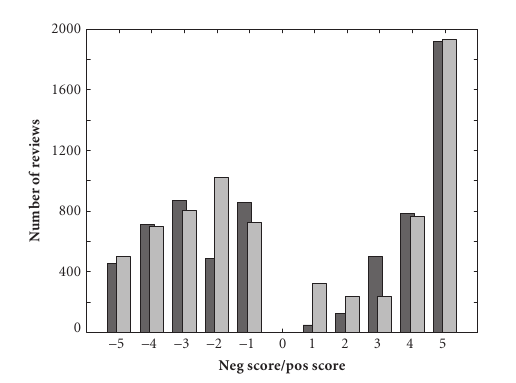
Modeling collective emotions in online social systems
|
[2014]
|
|
Garcia, David;
Garas, Antonios;
Schweitzer, Frank
|
Collective Emotions
|
more» «less
|
Abstract
Every day, millions of Internet users leave online traces that are publicly accessible. Data
about forum comments, video downloads, or product reviews provide a valuable insight
into human online behavior. The retrieval of datasets of unprecedented size may eventu-
ally also allow testing of hypotheses or validation of theories that have been developed in
the social sciences, for example, about preferences, social influence (Lorenz, 2009; Onnela
& Reed-Tsochas, 2010), trust, and cooperation (Walter, Battiston, Yildirim, & Schweitzer,
2011). This recent scientific development has led to the emerging field of computational
social science (Lazer et al., 2009) which combines methods and tools from different tech-
nical and social disciplines. Also, psychology can benefit from this development by get-
ting access to data without designing expensive experimental setups of limited size. For
example, the analysis of Twitter messages allows studying the influence of the circadian
cycles on human mood (Golder & Macy, 2011), and sentiment analysis of large-scale
datasets reveals patterns of emotional expression predicted by earlier theories (Garcia,
Garas, & Schweitzer, 2012).

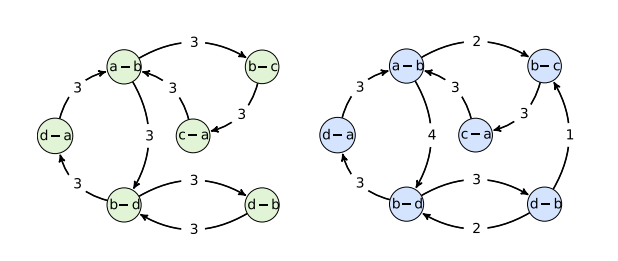
Causality-driven slow-down and speed-up of diffusion in non-Markovian temporal networks
|
[2014]
|
|
Scholtes, Ingo;
Wider, Nicolas;
Pfitzner, Rene;
Garas, Antonios;
Tessone, Claudio Juan;
Schweitzer, Frank
|
Nature Communications,
pages: 5024,
volume: 5
|
more» «less
|
Abstract
Recent research has highlighted limitations of studying complex systems with time-varying topologies from the perspective of static, time-aggregated networks. Non-Markovian characteristics resulting from the ordering of interactions in temporal networks were identified as one important mechanism that alters causality and affects dynamical processes. So far, an analytical explanation for this phenomenon and for the significant variations observed across different systems is missing. Here we introduce a methodology that allows to analytically predict causality-driven changes of diffusion speed in non-Markovian temporal networks. Validating our predictions in six data sets we show that compared with the time-aggregated network, non-Markovian characteristics can lead to both a slow-down or speed-up of diffusion, which can even outweigh the decelerating effect of community structures in the static topology. Thus, non-Markovian properties of temporal networks constitute an important additional dimension of complexity in time-varying complex systems.

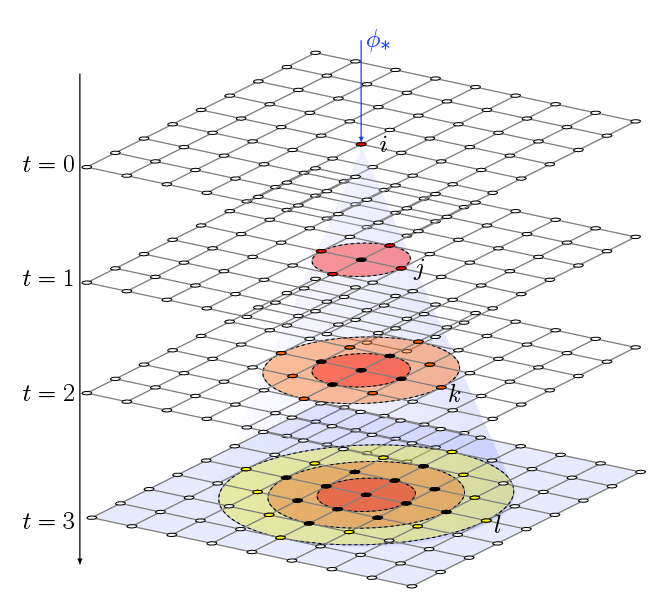
How big is too big? Critical shocks for systemic failure cascades
|
[2013]
|
|
Tessone, Claudio Juan;
Garas, Antonios;
Guerra, Beniamino;
Schweitzer, Frank
|
Journal of Statistical Physics,
pages: 765-783,
volume: 151,
number: 3
|
more» «less
|
Abstract
External or internal shocks may lead to the collapse of a system consisting of many agents. If the shock hits only one agent initially and causes it to fail, this can induce a cascade of failures among neighoring agents. Several critical constellations determine whether this cascade remains finite or reaches the size of the system, i.e. leads to systemic risk. We investigate the critical parameters for such cascades in a simple model, where agents are characterized by an individual threshold $$theta_i determining their capacity to handle a load $$alpha$$theta_i with 1-$$alpha being their safety margin. If agents fail, they redistribute their load equally to K neighboring agents in a regular network. For three different threshold distributions P($$theta), we derive analytical results for the size of the cascade, X(t), which is regarded as a measure of systemic risk, and the time when it stops. We focus on two different regimes, (i) EEE, an external extreme event where the size of the shock is of the order of the total capacity of the network, and (ii) RIE, a random internal event where the size of the shock is of the order of the capacity of an agent. We find that even for large extreme events that exceed the capacity of the network finite cascades are still possible, if a power-law threshold distribution is assumed. On the other hand, even small random fluctuations may lead to full cascades if critical conditions are met. Most importantly, we demonstrate that the size of the "big" shock is not the problem, as the systemic risk only varies slightly for changes of 10 to 50 percent of the external shock. Systemic risk depends much more on ingredients such as the network topology, the safety margin and the threshold distribution, which gives hints on how to reduce systemic risk.

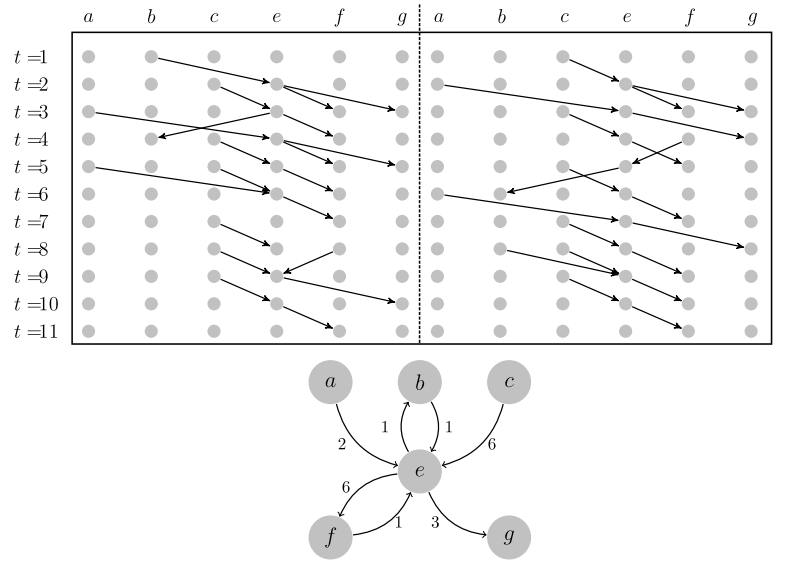
Betweenness preference: Quantifying correlations in the topological dynamics of temporal networks
|
[2013]
|
|
Pfitzner, Rene;
Scholtes, Ingo;
Garas, Antonios;
Tessone, Claudio Juan;
Schweitzer, Frank
|
Physical Review Letters,
pages: 198701,
volume: 110,
number: 19
|
more» «less
|
Abstract
Time-evolving interaction patterns studied in different contexts can be well represented bytemporal networks in which nodes are intermittently connected. In this Letter we introducethe notion of betweenness preference in the study of temporal networks. It captures how likelya certain node is to mediate interactions between particular pairs of its neighboring nodes.We argue that betweenness preference is an important correlation to consider in the analysisof temporal network data. In particular, it allows to assess to which extent paths existing intime-aggregated, static representations of temporal networks are actually feasible based onthe underlying sequence of interactions. We argue that betweenness preference correlationsare present in empirical data sets. We further show that neglecting betweenness preferencewill lead to significantly wrong statements about spreading dynamics in temporal networks.

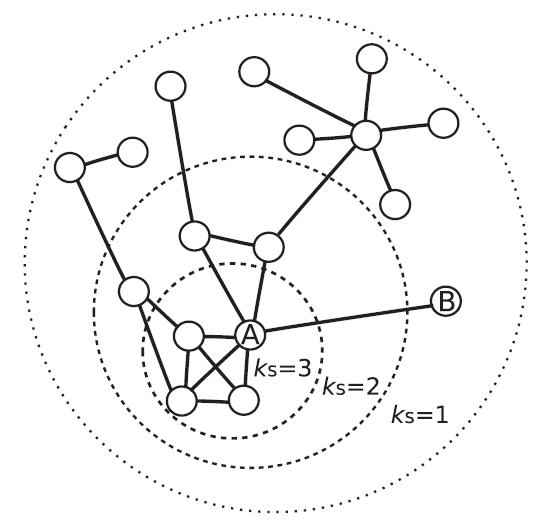
A k-shell decomposition method for weighted networks
|
[2012]
|
|
Garas, Antonios;
Schweitzer, Frank;
Havlin, Shlomo
|
New Journal of Physics,
pages: 083030,
volume: 14,
number: 8
|
more» «less
|
Abstract
We present a generalized method for calculating the k-shell structure of weighted networks. The method takes into account both the weight and the degree of a network, in such a way that in the absence of weights we resume the shell structure obtained by the classic k-shell decomposition. In the presence of weights, we show that the method is able to partition the network in a more refined way, without the need of any arbitrary threshold on the weight values. Furthermore, by simulating spreading processes using the susceptible-infectious-recovered model in four different weighted real-world networks, we show that the weighted k-shell decomposition method ranks the nodes more accurately, by placing nodes with higher spreading potential into shells closer to the core. In addition, we demonstrate our new method on a real economic network and show that the core calculated using the weighted k-shell method is more meaningful from an economic perspective when compared with the unweighted one.

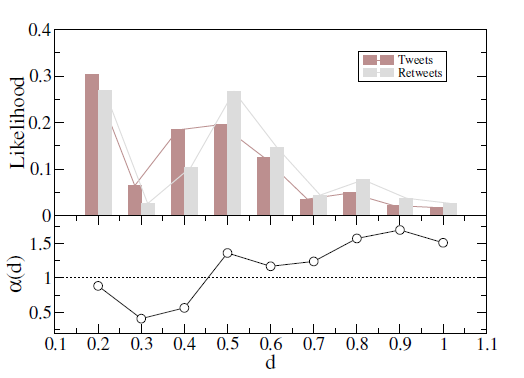
Emotional divergence influences information spreading in Twitter
|
[2012]
|
|
Pfitzner, Rene;
Garas, Antonios;
Schweitzer, Frank
|
Sixth International AAAI Conference on Weblogs and Social Media,
pages: 2-- 5
|
more» «less
|
Abstract
We analyze data about the micro-blogging site Twitter using sentiment extraction techniques. From an information per- spective, Twitter users are involved mostly in two processes: information creation and subsequent distribution (tweeting), and pure information distribution (retweeting), with pro- nounced preference to the first. However a rather substantial fraction of tweets are retweeted. Here, we address the role of the sentiment expressed in tweets for their potential after- math. We find that although the overall sentiment (polarity) does not influence the probability of a tweet to be retweeted, a new measure called emotional divergence does have an im- pact. In general, tweets with high emotional diversity have a better chance of being retweeted, hence influencing the dis- tribution of information.


Time-explicit graphs: A framework for dynamic network analysis
|
[2012]
|
|
Pfitzner, Rene;
Scholtes, Ingo;
Tessone, Claudio Juan;
Garas, Antonios;
Schweitzer, Frank
|
Extended Poster Abstract at Summer School "Modeling and Analysis of Novel Mechanisms in Future Internet Applications", Würzburg
|
more» «less
|
Abstract
When dealing with networks of several kind, network theory provides the theoretical framework and the practical tools to analyze them. Mostly analysis focuses on steady networks, i.e. networks with fixed topology. However, real-world scenarios often deal with (highly) dynamic topologies. As of today, the question of how to investigate such scenarios, e.g. defining a meaningful notion of “temporal centrality”, has generally not been answered. In this poster we present research pointing out the obstacles arising in this endeavor as well as a possible framework to address those issues, which we call time-explicit graphs.


Positive words carry less information than negative words
|
[2012]
|
|
Garcia, David;
Garas, Antonios;
Schweitzer, Frank
|
EPJ Data Science,
pages: 3,
volume: 1
|
more» «less
|
Abstract
We show that the frequency of word use is not only determined by the word length [1] and the average information content [2], but also by its emotional content.We have analysed three established lexica of affective word usage in English, German, and Spanish, to verify that these lexica have a neutral, unbiased, emotional content. Taking into account the frequency of word usage, we find that words with a positive emotional content are more frequently used. This lends support to Pollyanna hypothesis [3] that there should be a positive bias in human expression. We also find that negative words contain more information than positive words, as the informativeness of a word increases uniformly with its valence decrease. Our findings support earlier conjectures about (i) the relation between word frequency and information content, and (ii) the impact of positive emotions on communication and social links.

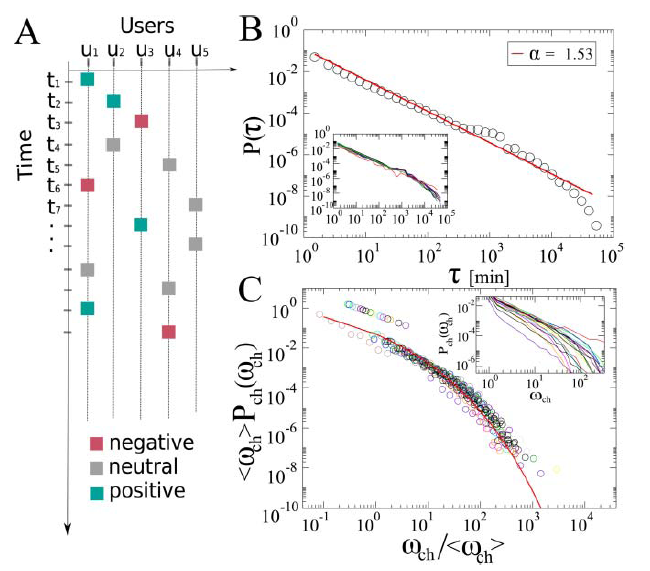
Emotional persistence in online chatting communities
|
[2012]
|
|
Garas, Antonios;
Garcia, David;
Skowron, Marcin;
Schweitzer, Frank
|
Scientific Reports,
pages: 402,
volume: 2
|
more» «less
|
Abstract
How do users behave in online chatrooms, where they instantaneously read and write posts? We analyzed about 2.5 million posts covering various topics in Internet relay channels, and found that user activity patterns follow known power-law and stretched exponential distributions, indicating that online chat activity is not different from other forms of communication. Analysing the emotional expressions (positive, negative, neutral) of users, we revealed a remarkable persistence both for individual users and channels. I.e. despite their anonymity, users tend to follow social norms in repeated interactions in online chats, which results in a specific emotional “tone” of the channels. We provide an agent-based model of emotional interaction, which recovers qualitatively both the activity patterns in chatrooms and the emotional persistence of users and channels. While our assumptions about agent's emotional expressions are rooted in psychology, the model allows to test different hypothesis regarding their emotional impact in online communication.

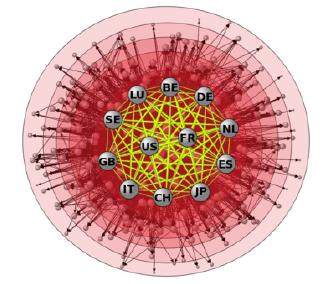
Worldwide spreading of economic crisis
|
[2010]
|
|
Garas, Antonios;
Argyrakis, Panos;
Rozenblat, C'eline;
Tomassini, Marco;
Havlin, Shlomo
|
New Journal of Physics,
pages: 113043,
volume: 12,
number: 11
|
more» «less
|
Abstract
We model the spreading of a crisis by constructing a global economic network and applying the susceptible–infected–recovered (SIR) epidemic model with a variable probability of infection. The probability of infection depends on the strength of economic relations between a given pair of countries and the strength of the target country. It is expected that a crisis that originates in a large country, such as the USA, has the potential to spread globally, such as the recent crisis. Surprisingly, we also show that countries with a much lower GDP, such as Belgium, are able to initiate a global crisis. Using the k-shell decomposition method to quantify the spreading power (of a node), we obtain a measure of ‘centrality’ as a spreader of each country in the economic network.We thus rank the different


Filtering of complex systems using overlapping tree networks
|
[2009]
|
|
Garas, Antonios;
Argyrakis, Panos
|
EPL (Europhysics Letters),
pages: 28005,
volume: 86,
number: 2
|
more» «less
|
Abstract
We introduce a technique that is capable to filter out information from complex systems, by mapping them to networks, and extracting a subgraph with the strongest links. This idea is based on the Minimum Spanning Tree, and it can be applied to sets of graphs that have as links different sets of interactions among the system’s elements, which are described as network nodes. It can also be applied to correlation-based graphs, where the links are weighted and represent the correlation strength between all pairs of nodes. We applied this method to the European scientific collaboration network, which is composed of all the projects supported by the European Framework Program FP6, and also to the correlation-based network of the 100 highest capitalized stocks traded in the New York Stock Exchange. For both cases we identified meaningful structures, such as a strongly interconnected community of countries that play an important role in the collaboration network, and clusters of stocks belonging to different sectors of economic activity, which gives significant information about the investigated systems.

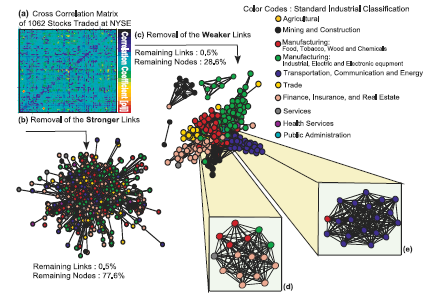
The structural role of weak and strong links in a financial market network
|
[2008]
|
|
Garas, Antonios;
Argyrakis, Panos;
Havlin, Shlomo
|
The European Physical Journal B,
pages: 265-- 271,
volume: 63,
number: 2
|
more» «less
|
Abstract
We investigate the properties of correlation based networks originating from economic complex systems, such as the network of stocks traded at the New York Stock Exchange (NYSE). The weaker links (low correlation) of the system are found to contribute to the overall connectivity of the network significantly more than the strong links (high correlation). We find that nodes connected through strong links form well defined communities. These communities are clustered together in more complex ways compared to the widely used classification according to the economic activity.We find that some companies, such as General Electric (GE), Coca Cola (KO), and others, can be involved in different communities. The communities are found to be quite stable over time. Similar results were obtained by investigating markets completely different in size and properties, such as the Athens Stock Exchange (ASE). The present method may be also useful for other networks generated through correlations.

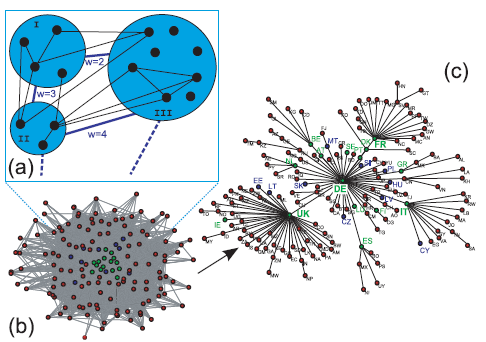
A network approach for the scientific collaboration in the European framework programs
|
[2008]
|
|
Garas, Antonios;
Argyrakis, Panos
|
EPL (Europhysics Letters),
pages: 68005,
volume: 84,
number: 6
|
more» «less
|
Abstract
We construct the networks of collaboration between partners for projects carried out with the support of European Commission Framework Programs FP5 and FP6. We analyze in detail these networks, not only in terms of total number of projects, but also for the different tools employed, the different geographical partitions, and the different thematic areas. For all cases we find a scale-free behavior, as expected for such social networks, and also reported in the literature. In comparing FP5 to FP6, we show that, despite a decrease in the number of signed contracts, and the total number of unique partners, there is an increase in the average number of collaborative partners per institution. Furthermore, we establish a measure for the central role (hub) for each country, by using the Minimum Spanning Tree (MST), which we construct in detail for each thematic area (e.g. Informatics, Nanoscience, Life Sciences, etc.). The importance of these network hubs is highlighted, as this information can be used by policy planners in designing future research plans regarding the distribution of available funds.

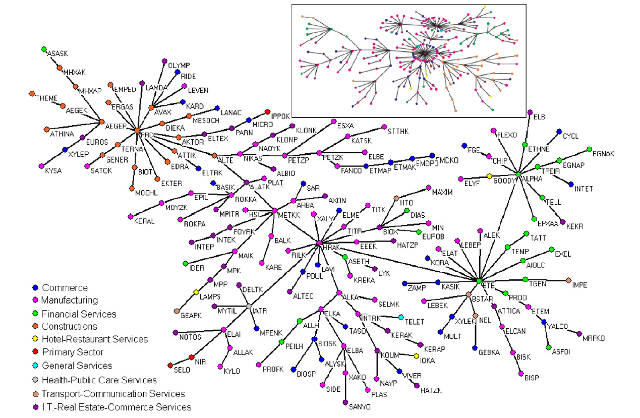
Correlation study of the athens stock exchange
|
[2007]
|
|
Garas, Antonios;
Argyrakis, Panos
|
Physica A: Statistical Mechanics and its Applications,
pages: 399-- 410,
volume: 380
|
more» «less
|
Abstract
We study the year-after-year properties of three different portfolios traded in the Athens Stock Exchange (ASE) for the
time period 1987–2004. We use the minimum spanning tree (MST) technique and the random matrix theory (RMT), which make it possible to examine at the same time the temporal evolution of the portfolios and of the market as a whole. The first four moments of the distribution of correlations and the normalized tree lengths of the MST show a similar behaviour for all three portfolios. However, by studying topological properties of the MST, such as the node degree k, we are able to identify changes to the MST associated to each portfolio that are due to a crisis in the market, like the one that happened during the period 1999–2001. We also see that, while the effect of the market to the information content of the correlation matrix for all three portfolios is almost the same, the market is affected differently by different economic sectors at different time periods.
Talks»
«Talks
Talks
Systemic risk in multiplex networks with asymmetric coupling and threshold feedback
[Sept. 19, 2016 - Sept. 22, 2016]
2016 Conference on Complex Systems, Amsterdam, The Netherlands
The role of networks in firms’ multi-characteristics competition and market-share inequality
[Sept. 19, 2016 - Sept. 22, 2016]
2016 Conference on Complex Systems, Amsterdam, The Netherlands
The Temporal Dimension of Complex Networks
[April 22, 2016 - April 24, 2016]
Second Annual NSF Conference on Network Science in Economics, Stanford University, CA, USA
Exploring the controllable space of multi-layered networks
[June 1, 2015]
Satellite Workshop "Physics of multilayered interconnected networks II", NetSci 2015, Zaragoza, Spain
Complex networks and applications to social & economic systems
[May 14, 2015]
Invited Talk at "Multivariate Causality Measures" (MCM'15) Seminar, University of Macedonia, Thessaloniki, Greece
Alliance formation in R&D networks, and the role of geography
[May 13, 2015]
Seminar Talk at University of Ioannina (UoI), Ioannina, Greece
How Damage Diversification Can Reduce Systemic Risk
[May 1, 2015 - May 3, 2015]
Conference on Information Transmission in Networks, Harvard University, Cambridge, MA, USA
The importance of non-Markovianinty in temporal networks
[Dec. 9, 2014]
Seminars in Systems and Control, UCL Louvain
Reaction-diffusion models of conflicting information in multi-layered networks
[Sept. 25, 2014]
COINETS14, Lucca, Italy
Cities and economic activities: a mutualistic dependence
[Sept. 25, 2014]
3rd International Workshop on Citizen Networks - CitiNet 25th September 2014, Lucca Italy
Centrality-based career paths, success, and social influence
[Sept. 24, 2014]
Quantifying Success 2.0 at ECCS 2014, Lucca, Italy
Predicting Scientific Success Based on Co-authorship Networks
[Sept. 23, 2014]
ECCS 2014, Lucca, Italy
Weighting the weights: k-shell decomposition and applications to weighted economic networks
[June 5, 2014]
International School and Conference on Network Science (NetSci 2014), Berkeley, California CA, USA
Alliance formation in R&D networks, and the role of geography
[May 2, 2014]
COST IS1104 workshop "The Geography of Financial Networks", Aix-Marseille Université, Aix en Provence,France
Betweenness Preference: Quantifying Correlations in the Topological Dynamics of Temporal Networks
[Sept. 17, 2013]
European Conference on Complex Systems (ECCS), Barcelona, Spain
What do we lose when we aggregate temporal networks?
[June 3, 2013]
The International Workshop and Conference on Network (NetSci) satellite workshop "Temporal and Dynamic Networks: From Data to Models", Copenhagen, Denmark
The role of emotions in on-line communication
[March 25, 2012 - March 30, 2012]
Deutsche Physikalische Gesellschaft (DPG) Annual Conference, Berlin, Germany
k-shells on weighted networks
[March 25, 2012 - March 30, 2012]
Deutsche Physikalische Gesellschaft (DPG) Annual Conference, Berlin, Germany
|






































































